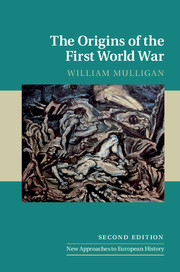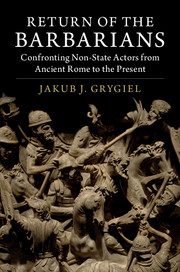Refine search
Actions for selected content:
15418 results in Military history

Captive Anzacs
- Australian POWs of the Ottomans during the First World War
-
- Published online:
- 16 June 2018
- Print publication:
- 01 May 2018

At War's Summit
- The Red Army and the Struggle for the Caucasus Mountains in World War II
-
- Published online:
- 15 June 2018
- Print publication:
- 28 June 2018
6 - Settlements, Local Forces, Fortifications, and Altering the Environment
-
- Book:
- Return of the Barbarians
- Published online:
- 24 May 2018
- Print publication:
- 07 June 2018, pp 184-209
-
- Chapter
- Export citation
Acknowledgments
-
- Book:
- Return of the Barbarians
- Published online:
- 24 May 2018
- Print publication:
- 07 June 2018, pp viii-x
-
- Chapter
- Export citation
Dedication
-
- Book:
- Return of the Barbarians
- Published online:
- 24 May 2018
- Print publication:
- 07 June 2018, pp v-vi
-
- Chapter
- Export citation
Index
-
- Book:
- Return of the Barbarians
- Published online:
- 24 May 2018
- Print publication:
- 07 June 2018, pp 219-222
-
- Chapter
- Export citation
7 - Conclusion
-
- Book:
- Return of the Barbarians
- Published online:
- 24 May 2018
- Print publication:
- 07 June 2018, pp 210-218
-
- Chapter
- Export citation
5 - Three Saints and the Barbarian Threat
-
- Book:
- Return of the Barbarians
- Published online:
- 24 May 2018
- Print publication:
- 07 June 2018, pp 154-183
-
- Chapter
- Export citation
Introduction
-
- Book:
- Return of the Barbarians
- Published online:
- 24 May 2018
- Print publication:
- 07 June 2018, pp 1-11
-
- Chapter
- Export citation
3 - The Return of Premodern History?
-
- Book:
- Return of the Barbarians
- Published online:
- 24 May 2018
- Print publication:
- 07 June 2018, pp 86-121
-
- Chapter
- Export citation
2 - Barbarians and the Character of the Competition
-
- Book:
- Return of the Barbarians
- Published online:
- 24 May 2018
- Print publication:
- 07 June 2018, pp 48-85
-
- Chapter
- Export citation
4 - Altering the State
-
- Book:
- Return of the Barbarians
- Published online:
- 24 May 2018
- Print publication:
- 07 June 2018, pp 122-153
-
- Chapter
- Export citation
Contents
-
- Book:
- Return of the Barbarians
- Published online:
- 24 May 2018
- Print publication:
- 07 June 2018, pp vii-vii
-
- Chapter
- Export citation
1 - The Nature of the Premodern Strategic Environment
-
- Book:
- Return of the Barbarians
- Published online:
- 24 May 2018
- Print publication:
- 07 June 2018, pp 12-47
-
- Chapter
- Export citation
Copyright page
-
- Book:
- Return of the Barbarians
- Published online:
- 24 May 2018
- Print publication:
- 07 June 2018, pp iv-iv
-
- Chapter
- Export citation

World War One
- The Global Revolution
-
- Published online:
- 28 May 2018
- Print publication:
- 31 March 2011
-
- Book
- Export citation

The Origins of the First World War
-
- Published online:
- 28 May 2018
- Print publication:
- 13 April 2017
-
- Textbook
- Export citation

Return of the Barbarians
- Confronting Non-State Actors from Ancient Rome to the Present
-
- Published online:
- 24 May 2018
- Print publication:
- 07 June 2018
2 - The Ballad of Frankie Seto
- from Part I - The Reach of American Racism?
-
- Book:
- Japanese American Relocation in World War II
- Published online:
- 24 April 2018
- Print publication:
- 03 May 2018, pp 24-39
-
- Chapter
- Export citation
Preface
-
- Book:
- Japanese American Relocation in World War II
- Published online:
- 24 April 2018
- Print publication:
- 03 May 2018, pp xi-xvi
-
- Chapter
- Export citation
